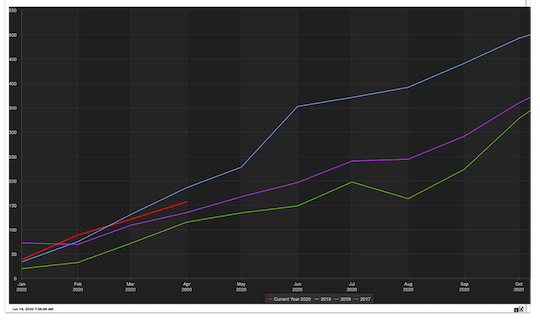Central Banks Driving Gold
Tyler Durden
Wed, 07/01/2020 – 19:05
Authored by James Rickards via The Daily Reckoning,
Gold as an asset class is confusing to most investors. Even sophisticated investors are accustomed to hearing gold ridiculed as a “shiny rock” and hearing serious gold analysts mocked as “gold bugs,” “gold nuts” or worse.
As a gold analyst, I grew used to this a long time ago. But, it’s still disconcerting when one realizes the extent to which gold is simply not taken seriously or is treated as a mere commodity no different than soy beans or wheat.
The reasons for this disparaging approach to gold are not difficult to discern. Economic elites and academic economists control the central banks. The central banks control what we now consider “money” (dollars, euros, yen and other major currencies).
Those who control the money supply can indirectly control economies and the destiny of nations simply by deciding when and how much to ease or tighten credit conditions, and when to favor (or disfavor) certain types of lending.
When you ease credit conditions in a difficult environment, you help favored institutions (mainly banks) to survive. If you tighten credit conditions in a difficult environment, you can more or less guarantee that certain companies, banks or even nations will fail.
This power is based on money and the money is controlled by central banks, primarily the Federal Reserve System. However, the money-based power depends on a monopoly on money creation.
As long as investors and institutions are forced into a dollar-based system, then control of the dollar equates to control of those institutions. The minute another form of money competes with the dollar (or euro, etc.) as a store of value and medium of exchange, then the control of the power elites is broken.
This is why the elites disparage and marginalize gold. It’s easy to show why gold is a better form of money, why it’s more reliable than central bank money for preserving wealth, and why it’s a threat to the money-monopoly that the elites depend upon to maintain power.
Not only is gold a superior form of money, it’s also not under the control of any central bank or group of individuals. Yes, miners control new output, but annual output is only about 1.8% of all the above-ground gold in the world.
The value of gold is determined not by new output, but by the above-ground supply, which is 190,000 metric tonnes. Most of that above-ground supply is either owned by central banks and finance ministries (about 34,000 metric tonnes) or is held privately either as jewelry (“wearable wealth”) or bullion (coins and bars).
The floating supply available for day-to-day trading and investment is only a small fraction of the total supply. Gold is valuable and is a powerful form of money, but it’s not under the control of any single institution or group of institutions.
Clearly gold is a threat to the central bank money monopoly. Gold cannot be made to disappear (it’s too valuable), and it would be almost impossible to confiscate (despite persistent rumors to that effect).
If gold is a threat to central bank money and cannot be made to disappear, then it must be discredited. It becomes important for central bankers and academic economists to construct a narrative that’s easily absorbed by everyday investors that says gold is not money.
The narrative goes like this:
There’s not enough gold in the world to support trade and commerce.(That’s false: there’s always enough gold, it’s just a question of price. The same amount of gold supports a larger amount of transactions when the price is raised).
Gold supply cannot expand fast enough to keep up with economic growth.(That’s false: It confuses the official supply with the total supply. Central banks can always expand the official supply by printing money and buying gold from private hands. That expands the money supply and supports economic expansion).
Gold causes financial panics and crashes.(That’s false: There were panics and crashes during the gold standard and panics and crashes since the gold standard ended. Panics and crashes are not caused or cured by gold. They are caused by a loss of confidence in banks, paper money or the economy. There is no correlation between gold and financial panic).
Gold caused and prolonged the Great Depression.(That’s false: Even Milton Friedman and Ben Bernanke have written that the Great Depression was caused by the Fed. During the Great Depression, base money supply could be 250% of the market value of official gold. Actual money supply never exceeded 100% of the gold value. In other words, the Fed could have more than doubled the money supply even with a gold standard. It failed to do so. That’s a Fed failure not a gold failure).
You get the point. There’s a clever narrative about why gold is not money. But, the narrative is false. It’s simply the case that everyday citizens believe what the economists say (usually a bad idea) or don’t know enough economic history to refute the economists (and how could you know the history if they stopped teaching it fifty years ago).
The bottom line is that economists know that gold could be a perfectly usable form of money. The reason they don’t want it is because it dilutes their monopoly power over printed money and therefore reduces their political power over people and nations.
To marginalize gold, they created a phony narrative about why gold doesn’t work as money. Most people were too easily impressed by the narrative or simply didn’t know enough to challenge it. Therefore the narrative wins even if it is false.
If gold is viable as a form of money, what does gold’s recent price trading range combined with fundamental factors tell us about its investment prospects?
Right now, my models are telling me that gold is poised to breakout of its recent narrow trading range.
As always in technical analysis, the term “breakout” can mean sharply higher or sharply lower prices. Using fundamental analysis, a breakout to sharply higher prices is the expected outcome. This may be the last opportunity to buy gold below $2,000 per ounce.
For the past three months, gold has been trading in a range between $1,685 per ounce and $1,790 per ounce (it’s trading at about $1,782 today). For most of those three months gold was trading in a fairly narrow band.
When trading a volatile asset narrows to that extent, it’s a sign that the asset is ready for a material technical breakout. The question is will gold breakout to the upside or downside?
To answer that question, we can turn to fundamental analysis. (Technical analysis is data rich and is useful for spotting patterns, but it has low predictive analytic power).
One of the most important fundamental factors forcing gold higher is shown in Chart 1 below. This shows central bank purchases of gold bullion from 2017 to 2020 (each year is shown as a separate line measured in metric tonnes on the left scale).
Chart 1 – Central Bank purchases of gold
(in metric tonnes) 2017 – 2020
Chart 1 shows significant purchases of gold with 2019 running ahead of 2017 and 2018 at about 500 metric tonnes.
The chart also shows over 150 metric tonnes of gold purchases through April 2020, which puts 2020 on track to show 450 metric tonnes purchased for the year if present trends hold.
Of course, the actual result could be higher or lower. Cumulative central bank purchases from January 2017 to April 2020 are approximately 2,050 metric tonnes.
In fact, central banks went from being net sellers to net buyers of gold in 2010, and that net buying position has persisted ever since. The largest buyers are Russia and China, but significant purchases have also been made by Iran, Turkey, Kazakhstan, Mexico and Vietnam.
Here’s the bottom line:
Central banks have a monopoly on central bank money. Gold is the competitor to central bank money and most central banks would prefer to ignore gold. Yet, central banks in the aggregate are net buyers of gold.
In effect, central banks are signaling through their actions that they are losing confidence in their own money and their money monopoly. They’re getting ready for the day when confidence in central bank money will collapse across the board. In that world, gold will be the only form of money anyone wants.
Central banks are voting with their printing presses in favor of gold. What are you waiting for?
Here’s a once in a lifetime opportunity to front run central banks and acquire your own gold at attractive prices before the curtain drops on paper money.
via ZeroHedge News https://ift.tt/2D0v2oK Tyler Durden

